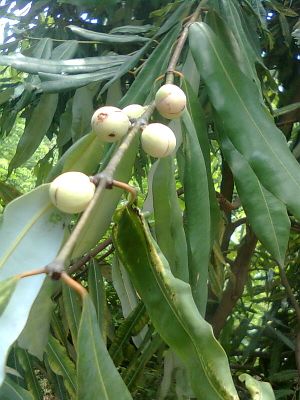Note: This is a project under development. The articles on this wiki are just being initiated and broadly incomplete. You can Help creating new pages.
Mesua ferrea linn - Nagapushpa
Mesua ferrea is a species in the family Calophyllaceae. This slow-growing tree is named after the heaviness and hardness of its timber. It is native to wet, tropical parts of Sri Lanka, India, southern Nepal, Burma, Thailand, Indochina, the Philippines, Malaysia and Sumatra.
Contents
[hide]- 1 Uses
- 2 Parts Used
- 3 Chemical Composition
- 4 Common names
- 5 Properties
- 6 Habit
- 7 Identification
- 8 List of Ayurvedic medicine in which the herb is used
- 9 Where to get the saplings
- 10 Mode of Propagation
- 11 How to plant/cultivate
- 12 Commonly seen growing in areas
- 13 Photo Gallery
- 14 References
- 15 External Links
Uses
Urinary tract infection, Gout, Itching, Swelling,Inflammatory disease, Indigestion, Fever, Excess thirst[1]
Parts Used
Dried folaige, Whole herb, Leaf, Bark, Flower, Seeds oil.
Chemical Composition
Contains Volatile oils, Flavonoids, Apigenin, Luteolin, Quercetin, Kaempferol, Tiliroside, Triterpene glycosides including euscapic acid and Tormentic acid, Phenolic acids, and 3%–21% tannins.[2]
Common names
| Language | Common name |
|---|---|
| Kannada | Kesara, Naagakeshara, Naagachampa, Naagasampige |
| Hindi | Gajapushpam, Nag-kesar |
| Malayalam | Behettachampagam, Bellutta-tsjampakam, Beluttachampagam |
| Tamil | Naagalingam, Aicilam, Aicilanakappu, Akiputam |
| Telugu | Chikatimanu, Cikatimanu, Gajapushpamu, |
| Marathi | NA |
| Gujarathi | NA |
| Punjabi | NA |
| Kashmiri | NA |
| Sanskrit | Nagkesara, Nagpushpa |
| English | Ironwood |
Properties
Reference: Dravya - Substance, Rasa - Taste, Guna - Qualities, Veerya - Potency, Vipaka - Post-digesion effect, Karma - Pharmacological activity, Prabhava - Therepeutics.
Dravya
Rasa
Tikta (Bitter), Kashaya (Astringent)
Guna
Laghu (Light), Ruksha (Dry), Tikshna (Sharp)
Veerya
Ushna (Hot)
Vipaka
Katu (Pungent)
Karma
Kapha, Vata
Prabhava
Habit
Identification
Leaf
| Kind | Shape | Feature |
|---|---|---|
| Simple | Lanceolate | The leaves are divided into 3-6 toothed leaflets, with smaller leaflets in between |
Flower
| Type | Size | Color and composition | Stamen | More information |
|---|---|---|---|---|
| Unisexual | 2-4cm long | White | 5-20 | Flowers fragrant white, large and solitary or in clusters. Flowering from February to May |
Fruit
| Type | Size | Mass | Appearance | Seeds | More information |
|---|---|---|---|---|---|
| Ovoid | 7–10 mm | Fruits ovoid with persistent calyx | Dark brown with oily and fleshy cotyledons | 1-4 | Fruiting from May to October |
Other features
List of Ayurvedic medicine in which the herb is used
Mahanarayana taila, Puga Khanda, Gulgulvasavam, Mahadraksha, Shringarabhra rasa, Amrita Praasha, Amrita Bhallataki, Amritaarishta, Ayapaan, Arimedaadi taila, Yelaadi Churna, Ashwagandharishta, Kandamoola Rasaayana, Kanakaasava, Kalyanaka Gritam, Kumariyaasava, Kumaaryasava, Kesha sanjivini Taila, Khadiraarishta, Chandanaadi tailam. Chavanaprash, Jatiphaladi Churnam, Jeeraka Bilvadi Lehyam, Jeerakaadyarishta, Triphaladi Lehyam, Nilibringaraja Taila, Narasimha Lehyam, Phalasugandhi Lehya, Pippaliyaasava, Bilvaadi lehya, Babbulaarishta [4]
Where to get the saplings
Mode of Propagation
How to plant/cultivate
Seed - easy to handle in the nursery with a germination that is good and rapid. Seedling germination is hypogeal.[5]
Commonly seen growing in areas
Mountains of eastern himalayas, East bengal, Wetland of Assam.
Photo Gallery
References
- Jump up ↑ Karnataka Medicinal Plants Volume - 2 by Dr.M. R. Gurudeva, Page No. 399
- Jump up ↑ Sciencedirect
- Jump up ↑ Plant description
- Jump up ↑ "Karnataka Medicinal Plants Volume - 2" by Dr.M. R. Gurudeva, Page No.125, Published by Divyachandra Prakashana, #45, Paapannana Tota, 1st Main road, Basaveshwara Nagara, Bengaluru.
- Jump up ↑ Cultivation details
External Links
- Ayurvedic Herbs known to be helpful to treat Urinary tract infection
- Ayurvedic Herbs known to be helpful to treat Gout
- Ayurvedic Herbs known to be helpful to treat Itching
- Ayurvedic Herbs known to be helpful to treat Swelling
- Ayurvedic Herbs known to be helpful to treat Inflammatory disease
- Ayurvedic Herbs known to be helpful to treat Indigestion
- Ayurvedic Herbs known to be helpful to treat Fever
- Ayurvedic Herbs known to be helpful to treat Excess thirst
- Herbs with Dried folaige used in medicine
- Herbs with Whole herb used in medicine
- Herbs with Leaf used in medicine
- Herbs with Bark used in medicine
- Herbs with Flower used in medicine
- Herbs with Seeds oil used in medicine
- Herbs with common name in Kannada
- Herbs with common name in Hindi
- Herbs with common name in Malayalam
- Herbs with common name in Tamil
- Herbs with common name in Telugu
- Herbs with common name in Sanskrit
- Herbs with common name in English
- Habit - Tree
- Index of Plants which can be propagated by Seeds
- Index of Plants which can be propagated by Cuttings
- Herbs that are commonly seen in the region of Mountains of eastern himalayas
- Herbs that are commonly seen in the region of East bengal
- Herbs that are commonly seen in the region of Wetland of Assam
- Herbs
- Calophyllaceae








